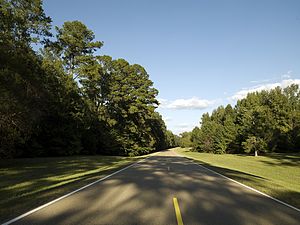National Parkway
| National Parkways | |
|---|---|
 Logo for the National Park Service | |
| Highway names | |
| Interstates | Interstate nn (I-nn) |
| US Highways | U.S. Highway nn, U.S. Route nn (US nn) |
| State | Varies by state |
| System links | |
A National Parkway is a designation for a protected area in the United States given to scenic roadways with a protected corridor of surrounding parkland. National Parkways often connect cultural or historic sites.[1] The U.S. National Park Service manages the parkways.
History
Parkways

The first parkways in the United States were developed in the late 19th century by landscape architects
During the early 20th century, the meaning of the word was expanded to include controlled-access highways designed for recreational driving of automobiles with landscaping. These parkways originally provided scenic routes without at-grade intersections, very slow vehicles, or pedestrian traffic. Their success led to more development however, expanding a city's boundaries, eventually limiting their recreational driving use. The Arroyo Seco Parkway between Downtown Los Angeles and Pasadena, California, is an example of lost pastoral aesthetics. It and others have become major commuting routes, while retaining the name parkway.
National parkways
In the 1930s, as part of the
List
This list is
units of the National Park System: Blue Ridge Parkway, George Washington Parkway, John D. Rockefeller Memorial Parkway, and Natchez Trace Parkway.[3] Others are managed as part of another unit.
The Great River Road was originally envisioned as a National Parkway. See alsoReferences
External links
|
